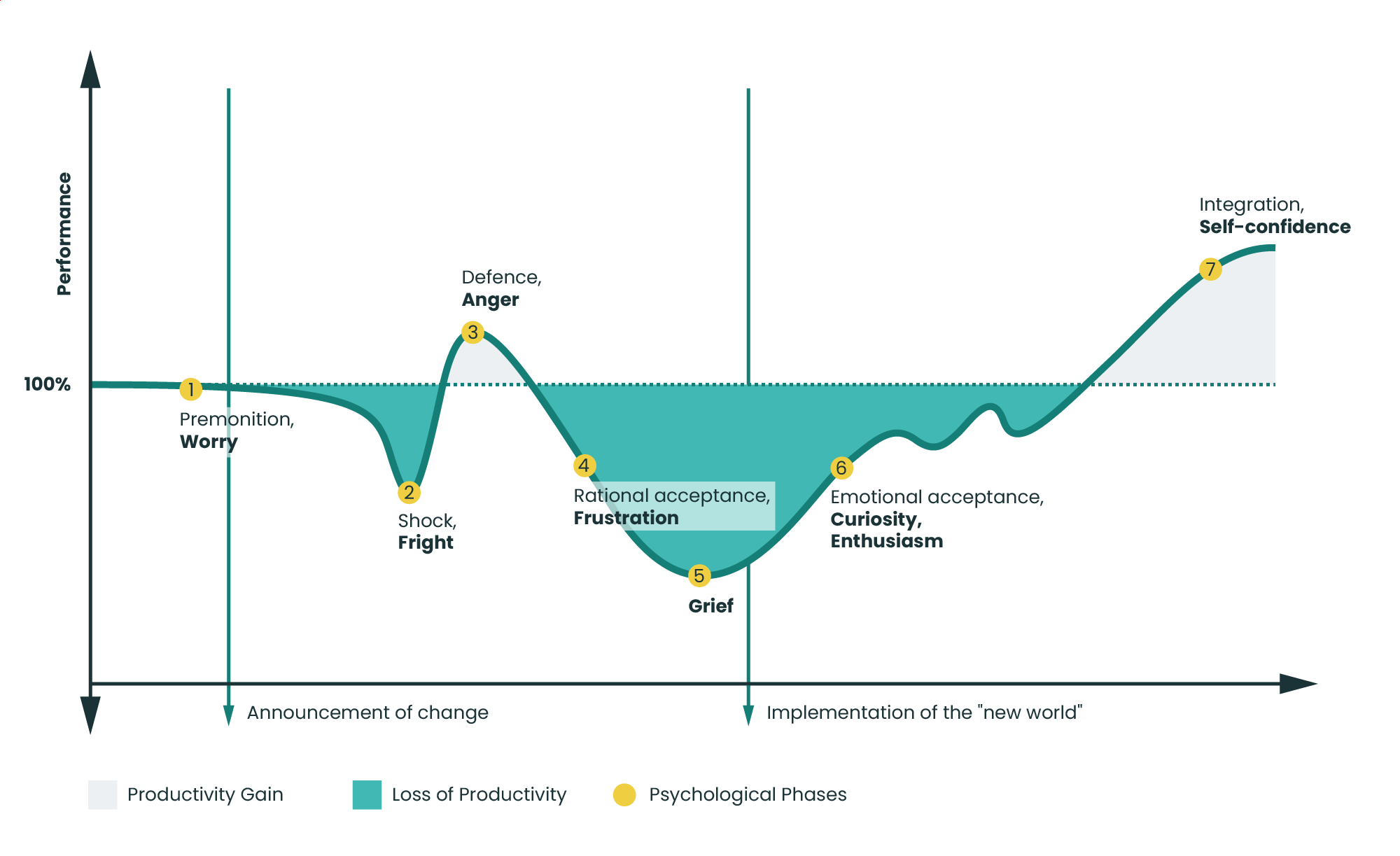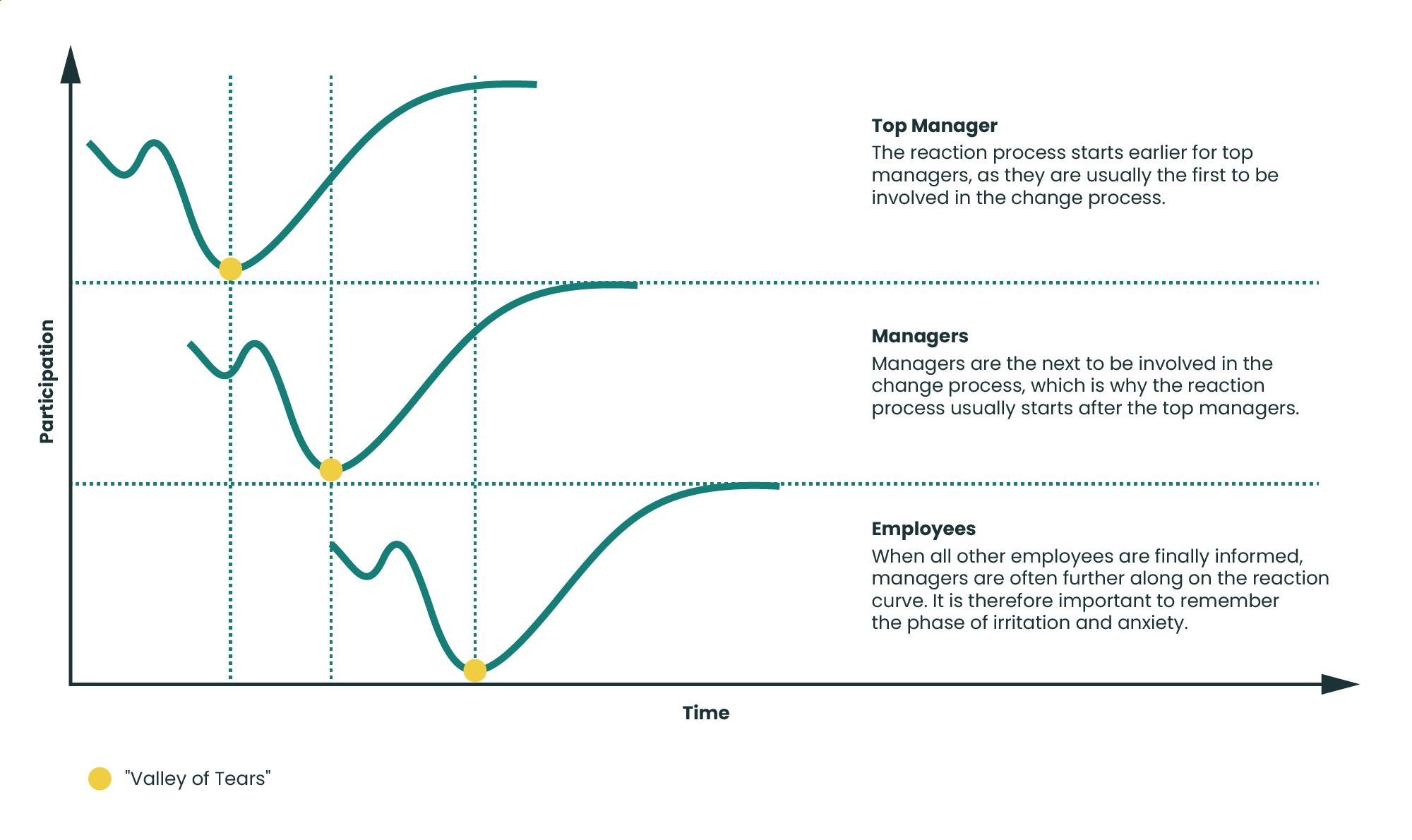Change management encompasses measures aimed at changing the overall organization, groups, or teams within the company.

Change Management: Embracing Change for More Efficient Processes
In today's business world, practically every area is subject to constant change. The reasons necessitating change can be multifaceted, such as:
- Digital transformation
- Company expansion/globalization
- Strategic realignment of the business
- Evolving expectations within the workforce
- Changes in the competitive environment
- Alterations in legal frameworks
Taking into account time, costs, and quality, change managers work from a current state (Is) toward a planned future state (Should). Typically, suitable Key Performance Indicators (KPIs) are utilized to establish or evaluate the status quo.
Goals of Change Management
The aim of change management is not only to bring about and prepare for necessary changes within the company but also to address potential resistance from employees and to promote acceptance of new ways of working. This involves integrating those affected into the change process and utilising their skills.
Even Small Changes Can Have a Big Impact
Before we delve into the science of change management, we'd like to take this opportunity to emphasize something we have learned through years of client projects and, not least, our own experience: Even small changes can make a big difference.
One example: If you streamline your communication channels and save a few minutes in task organization over the course of a fiscal year, you will already notice significant time savings.
Change Management in Science: Models and Psychological Phases
Change management originated in the 1930s. Below, we introduce some of the most well-known models and the psychological phases employees can go through during a change process.
Prominent Models of Change Management
5-Phase Model by Wilfried Krüger
The 5-Phase Model is considered one of the most common change management models, merging two other theories: the 3-Phase Model by Kurt Lewin and the 8-Step Model by John P. Kotter.
As the name implies, the change processes pass through 5 phases:
-
Initiation: Identifying the areas in need of change through an analysis of the current state (IST). This phase also involves appointing responsible change managers.
-
Conceptualization: During this phase, actions are identified and scheduled within a timeframe.
-
Motivation: The planned changes are communicated to the employees, emphasizing the positive aspects to foster acceptance.
-
Implementation: Prioritising the objectives set and implementing the planned changes under regular supervision.
-
Continuation: Employees are encouraged to internalize and solidify new routines or behaviors in their work routine, possibly preparing them for further changes.
ADKAR Model by Jeff Hiatt
Unlike Krüger's 5-Phase Model, Jeff Hiatt's ADKAR Model does not directly focus on the change process but on the individuals affected by it. The goal is to evoke a desire for change and reinforce it through successes.
-
Awareness: Sensitizing employees to changes and highlighting their necessity.
-
Desire: Creating a positive portrayal to generate a desire for change and encouraging people to engage in the process.
-
Knowledge: Providing the necessary knowledge to implement change processes.
-
Ability: Reinforcing previously acquired knowledge and providing all necessary (technical) means.
-
Reinforcement: After initial successes in change management, further empowering employees to drive changes within the company.
Psychological Phases in Change Management
Not all employees are immediately open to an impending change. It can mean letting go of "proven" behaviors for years and acquiring new skills — something not everyone is initially willing to do. Especially when change processes involve overtime or extra effort, acceptance is often low, and rejection is expected. Therefore, change management defines various psychological phases and their impacts on work productivity.
1# Anticipation
Changes rarely catch employees off guard. Instead, there's a sense of anticipation that something is on the horizon.
2# Shock
As soon as the management communicates their plans, employees often experience an initial shock state, affecting productivity.
3# Resistance
The initial shock can turn into noticeable resistance. This is not necessarily a strike. On the contrary, with a "now more than ever" mentality, employees aim to prove that the old system can still work, which increases their willingness to perform.
4# Rational Acceptance
In this phase, individuals realize that their resistance is not fruitful. However, they are not yet ready to embrace change and explore new paths.
5# Mourning
Right before implementation, frustration culminates in a "valley of tears", with productivity hitting its lowest point.
6# Emotional Acceptance
Post-implementation, employees acknowledge that there is no going back to the old system. They become more willing to leave past structures behind. This is partly because they recognize the potential behind new technologies or work methods, piquing their curiosity.
7# Integration
In daily interactions with the new structures, employees start experiencing initial successes and gain confidence. This is reflected in a significant increase in productivity.

When Should Change Processes Take Place?
Change processes should ideally take place BEFORE the implementation of new technologies and structures. By making it a priority to create transparency and address reservations beforehand, the actual transition becomes much easier for those involved and is generally better received. It is advisable to involve stakeholders and affected employees early in the decision-making process, especially when integrating software into the business routine.

Changes are often initiated at the strategic management level but should be communicated early to the lower levels.
Success Factors for Successful Change Management
Culture Analysis
Especially when planning a technological change and advancing business automation in your company, you have probably already analyzed your processes for improvement potential. However, in the context of change initiatives, it also makes sense to focus on your employees and their behaviors. Here, a culture analysis can be valuable. Its aim is to understand employee behavior and uncover potential barriers to change.
Leadership Coaching
The change process is likely to bring about personnel changes. Employees may find themselves in new roles, perhaps taking on personnel responsibilities for the first time. To facilitate a smooth transition for these employees, supporting them and providing leadership coaching is beneficial.
Employee Training
The daily work of your team can change significantly during a change process. To avoid frustration and ease the transition to new structures, adequate training for your employees is essential.
Project Management Tools
JIRA, Trello, Asana, or Basecamp: There is now a range of project management tools companies use to structure their tasks. It is likely your team already uses one. Change processes can also be organized using these programs by creating a ticket for individual tasks, assigning one or more responsible person(s), and scheduling the task.
Reporting
To assess the success of your change processes and identify further improvement potential, it is essential to provide detailed reporting. The best KPIs for this reporting will of course depend on the process, so here are just a few examples:
- Turnover rate
- Absenteeism
- Productivity
- Process cycle time
In addition to data-driven analysis, conducting employee surveys is vital. This way, you can precisely gauge how the changes are perceived by the staff and identify areas for further optimization from their perspective.
Team Building
Substantial changes can challenge your team and jeopardize the work environment. Team events strengthen the sense of belonging and provide a welcome break from the office routine.
External Change Managers
Depending on the goal and complexity of your change project, involving external consultants can be beneficial. They are familiar with the pitfalls and challenges, particularly in larger restructuring efforts and developing a new corporate strategy.
Why ESYON Recommends Change Processes
Change management is not part of ESYON's range of services. However, in collaboration with our clients, we consistently highlight the importance of change processes and aim to use our blog as a platform to do so.
Based on our experience, targeted change management significantly shortens project durations as your employees are prepared early for upcoming changes through seamless integration and process automation.
Conclusion
Changes within a company are necessary but not always welcomed by all employees. However, our experience from various client projects has shown that acceptance of new technologies and/or work methods is much higher when the transition is communicated transparently and employees are involved. For an ideal implementation, change managers should be appointed. These individuals can either come directly from your team, depending on resources and the project's scope, or they can be external consultants.
array(8) {
["@type"]=>
string(11) "NewsArticle"
["identifier"]=>
string(17) "#/schema/news/172"
["headline"]=>
string(64) "Change Management: Embracing Change for More Efficient Processes"
["datePublished"]=>
string(25) "2023-11-27T11:06:00+01:00"
["url"]=>
string(26) "/news/change-management-en"
["description"]=>
string(649) "Would you like to drive changes in your company? That can be challenging, as humans are creatures of habit. Many people tend to be critical of changes in their work environment, reacting with rejection or even fear. Yet, within every change lies an opportunity. When communicated early and transparently, involving all affected parties, your company can become even more efficient and shed the burdens of rigid and outdated processes.
To implement changes effectively within companies, Change Management has been established. In this article, we'll explain what it entails and why we consistently encourage our clients to undertake change processes."
["author"]=>
array(2) {
["@type"]=>
string(6) "Person"
["name"]=>
string(6) "Enrico"
}
["image"]=>
array(6) {
["@type"]=>
string(11) "ImageObject"
["caption"]=>
string(0) ""
["contentUrl"]=>
string(36) "/files/content/blog/stoerer/mann.jpg"
["identifier"]=>
string(51) "#/schema/image/ee76bf7d-9d92-11ee-b693-408d5c841e28"
["license"]=>
string(0) ""
["name"]=>
string(0) ""
}
}